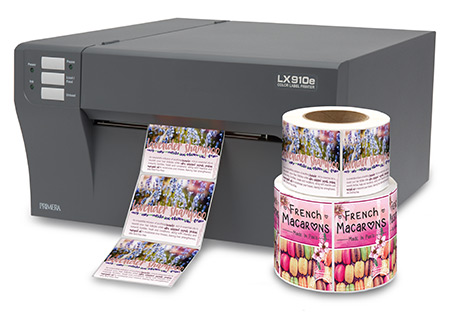
Primera Technology has today announced LX910e, its newest desktop colour label printer. LX910e is Primera’s fastest-ever desktop colour label printer. It can handle labels as wide as 8″ and as small as 0.75″. This latest addition can print a 4″ x 3″ label with 50% coverage in less than 6 seconds. In addition, ink costs are the lowest ever from Primera. This is due to a new, ultra-high capacity ink cartridge. On the same 4″ x 3″ label, cost per label is around $0.03 (USD) each.
Typical applications include product labels for coffee, wine, water, bakery, confectionery, meat, cheese and hundreds of other speciality and gourmet foods. The printer is also ideal for manufacturing, laboratory, security, government, retail, and a wide variety of other markets.
Compared to other printers that are comparably priced, LX910e has a number of distinct advantages:
- Print Speed: best-in-class throughput at up to 4.5″ per second.
- Print Quality: horizontal banding is a common problem with many lower-cost desktop colour label printers. Not so on LX910e. Banding is virtually eliminated – even on the faster print speeds.
- Interchangeable Dye or Pigment Inks: with a simple swap-out of ink cartridges, LX910e can print with dye-based ink for brilliant, eye-popping colour. Or, choose pigment ink for maximum durability against water and UV light. Both types of ink work interchangeably on the same printer.
- Single Ink SKU: LX910e utilizes an all-new, ultra-high capacity single CMY ink tank. You’ll only need to replace and keep on-hand one ink tank instead of two or four. This keeps your inventory simple and makes ink swaps fast and easy. Process black is dark and crisp. Best of all, process black uses no more ink than a separate black ink tank would for printing the same amount of text or graphics.
- Low Maintenance: Gone are the days of clogged nozzles, and unwieldy and expensive print head replacements. Users get a brand new print head each time they change the cartridge, simplifying maintenance and dramatically lowering on-going operating costs.
- Metal Case: instead of a cheaper plastic case that can break, LX910e has a tough, steel case with industrial-grade power-coated paint.
The LX910e sells for $2695.00. It is now available on Primera’s online store at www.primeralabel.eu.






I like the article
I enjoy the article